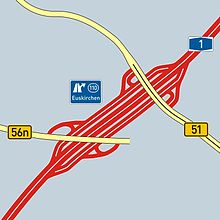Double junction
A double junction is a junction of a motorway or expressway that is structurally designed in such a way that two roads are connected with only one entry or exit in each direction of travel via distribution lanes.
The reason for the construction of double junctions is usually that two roads are to be connected that cross the motorway at short distances or run close by, so that there is not enough space for two independent junctions.
Examples
The Sonnborner Kreuz (31) on the A 46 in Wuppertal is an extremely complex double junction . There is a connection to the B 224 / A 535 to the north, to the B 228 to the east and west and to the L 74 and L 418 to the east. In the direction of Düsseldorf , all the streets listed can be reached via one exit. From the opposite direction, the connection to the L 75 and L 418 is only possible via a separate exit, which is signposted with Wuppertal-Cronenberg / Ronsdorf.
In the 1990s, the Euskirchen junction on the A 1 was converted into a double junction in order to create a connection to the newly built B 56n in addition to the existing connection to the B 51 / L 264 , which crosses the autobahn just 800 m away. The B 56n was designed as the A 56 and accordingly the new part of the junction was built as a motorway junction .
There are also double junctions on motorways outside of Germany. Junction points are combined there, especially in densely built-up areas. In Switzerland, for example, the junction Basel Hagnau or Basel St. Jakob (6) of Autobahn 2 is one of them.
Similar structures
An alternative for nodes located very close to the junction or several feeders can be the use of a roundabout as a junction that also connects the other roads.
Constructions with partially common properties or requirements are frontage roads . Nearby junction points use acceleration and deceleration strips that merge into one another or ramps that are crossed over for unbundling . These must be used if one of the connection points does not allow a straight passage due to the design and there is no distribution lane. One example is on the A113 of the terminal Schönefeld 52 ° 23 '50 " N , 13 ° 31' 8" O and 52 ° 23 '34 " N , 13 ° 31' 23" O .
